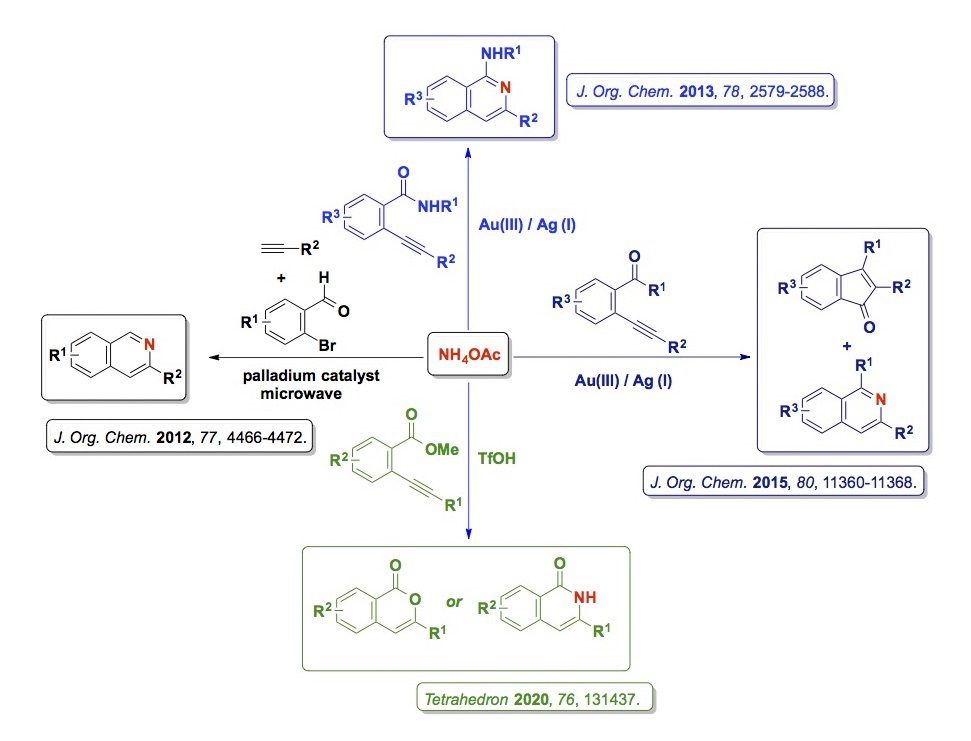
Dr. Yu Chen
ProfessorResearch
4) Iron-catalyzed reductive ring-opening of isoxazoles
As the second most abundant metal element in the earth’s crust, the environmentally friendly and low-cost properties of iron make it a very attractive catalyst. In addition, iron catalysts display various unique chemical reactivities different from the noble transition metals, which merits further attention. Iron-catalyzed transfer hydrogenation has attracted growing interest among chemists for its operational simplicity and economic nature. We recently developed an iron-catalyzed reductive ring-opening of isoxazoles and isoxazolines. The reaction took place via a transfer hydrogenation mechanism. An in-house aged N-methyl-2-pyrrolidone played the role as both a solvent and a hydrogen donor. We then employed the reductive ring-opening mechanism in two iron-catalyzed cascade reactions and successfully developed iron-mediated cascade syntheses of furans and pyrroles.

3) Iodine-induced intramolecular electrophilic cyclization
Halogen-induced electrophilic cyclization reactions have emerged as an indispensable method for the synthesis of cyclic compounds, as they occur under relatively mild conditions. These reactions provide a facile approach toward the synthesis of a variety of functionally substituted heterocyclic and carbocyclic compounds, by the ready modification of the halide functionality, and have therefore attracted a significant amount of attention from synthetic chemists. Our group designed a facile iodine monochloride-induced intramolecular cyclization of 1-([1,1′-biphenyl]-2-yl)-alkynones, leading to 6-iododibenzocyclohepten-5-ones in high chemical yields. The iodine functional group in the products promised further modification of the core structure through well-known palladium-catalyzed coupling reactions. During the course of developing the dibenzocyclohepten-5-one synthesis, we discovered an interesting substituent effect. In the presence of a para-methoxy group at the distal phenyl ring of the 1-([1,1′-biphenyl]-2-yl)-alkynones, an electrophilic iodocyclization selectively took place at the ipso position of the 1,1’-diphenyl bond, leading to a group of new spiroconjugated compounds. The substituent effect found significance in that, with minor modification to the substrate pattern, both ipso and ortho cyclization could be, regioselectively, “switched on” or “off”. The interesting electronic sensitivity provided the iodocyclization reaction potential synthetic utility, and promised its application in the developing field of chemical photonics, as well as material electrochemistry.

2) Palladium-catalyzed cascade reactions: synthesis of isoxazoles, naphthoisoxazoles, and 2-azafluorenones
Palladium-catalyzed cascade reactions have emerged as a valuable component in the synthesis of complex molecular scaffolds. In the presence of catalytic amounts of palladium, sequential transformations can take place in one pot with the formation of multiple chemical bonds. We first reported a palladium-catalyzed cyclization-alkenylation cascade synthesis of 3,4,5-trisubstituted isoxazoles. The two-step cascade reaction protocol was then derived to a three-step cascade reaction via the introduction of an ortho-arylbromide functionality to the oxime substrate, leading to the well known estrogen-receptor agonists and antagonists — naphthoisoxazoles. We further discovered a palladium-mediated tandem catalysis reaction via ring opening of isoxazoles and subsequent rearrangement of the β-imino ketone intermediate products, which led to 2-azafluorenones.

1) Synthesis of nitrogen-containing heterocycles employing ammonium acetate as the nitrogen source
Nitrogen-containing heterocycles are ubiquitous in natural products, pharmaceuticals, and materials science. Our interest in the late transition metal catalysis and heterocyclic chemistry has promoted our exploration of ammonium acetate (NH4OAc) as the ammonia source in the imination step of the late transition metal mediated cascade and one-pot synthesis. Our group first reported a palladium-catalyzed microwave-assisted one-pot reaction for the synthesis of isoquinolines. As a facile synthetic protocol towards isoquinolines, furopyridines and thienopyridines, the work was highlighted in SYNFACTS. We then developed gold-catalyzed domino syntheses of isoquinolines, 1-aminoisoquinolines, and indenones, as well as triflic acid mediated synthesis of isoquinolinones.


